Manitoba Insect & Disease Update: July 21, 2015
Summary
Levels of armyworms are starting to decline in some fields as they turn to pupae. Currently, scout for grasshoppers around field edges. In corn, now is the time to be scouting for European corn borer. Also consider scouting for aphids in cereals and pulse crops.
Pulse Crops
Soybean aphids: Soybean aphids have just started to show up in a few fields in Central Manitoba. Levels are currently very low in fields where they have been found. The economic threshold for soybean aphids in soybeans is at least 250 aphids per plants on average and the population still increasing, and plants in the beginning bloom to beginning seed growth stages. So this is something to watch for when scouting soybean fields, but still a long way form economic levels. Soybean aphids do not overwinter in Manitoba and are blown in. We usually don't have soybean aphids detected in Manitoba until some point in July. So one thing to note is that seed treatments containing insecticides likely won't provide protection against soybean aphids in Manitoba, as they would not be at effective levels by July based on trials on length of protection done in the US. So regardless of seed treatment used, it is good to monitor soybeans for aphids this time of year. But soybean growers are cautioned against treating sub-economic levels of soybean aphids as natural enemies, once established, can sometimes cause aphid populations to plateau or decline.
Aphids on peas. It is common to find pea aphid on peas this time of year. Aphids on peas have been reported from some area of western Manitoba, however there are no reports of control being needed yet. The economic threshold for aphids on peas is if, at the beginning of flowering, there are 9 to 12 aphids per sweep or 2-3 aphids per 8-inch (20 cm) plant tip. If this is surpassed an insecticide application when 50 percent of plants have produced some young pods will be cost-effective. Most of the damage that aphids do to peas is to the pods before they start to fill. If most of the pods have already started to fill, spraying would be too late and would not be economical.
Field Corn
European corn borer: European corn borer eggs are being noted in some fields, mainly at sub-economic levels, and in some fields young larvae can be found as well. Now is the time to be scouting for eggs masses and young larvae of European corn borer. Economic thresholds vary with crop value and control costs, but in general this year will be somewhere around one corn borer per plant on average. This is based on there being about a 5% yield loss per corn borer per plant. Figure 1 below shows a younger (upper) and older (lower) egg cluster of European corn borer.
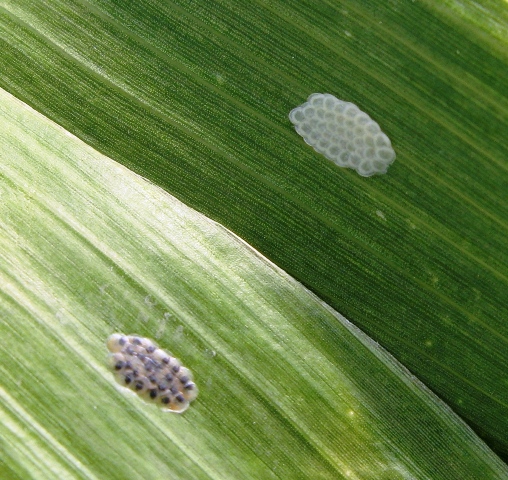
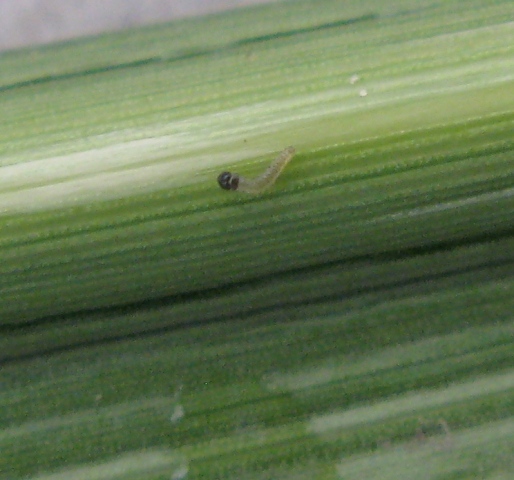
Figure 1. Egg masses of European corn borer. Figure 2. Young larva of European corn borer.
Oilseed Crops
Lygus bugs: When canola gets into the later flowering stages, it is good to use a sweep net to assess what levels of Lygus bugs are like. In years with good soil moisture, such as this year, canola would be able to do a good job compensating for feeding to flowers by Lygus bugs. So unless numbers where extremely high the feeding Lygus bugs would do to flowers would not be of economic concern. Lygus bugs will feed on young seeds. In the early podding stages, when seeds in the lower pods are still enlarging and translucent, the economic threshold is about 10 to 15 Lygus bugs in 10 sweeps on average.
It can become difficult to sweep a canola crop once pods start to enlarge. Aim for about 180 degree sweeps in a horizontal pattern through the upper canopy. If thick crop growth makes moving through the crop difficult, sweeps can be done closer to the field edge for Lygus bugs in canola (although note that this does not apply to all potential pests of canola).
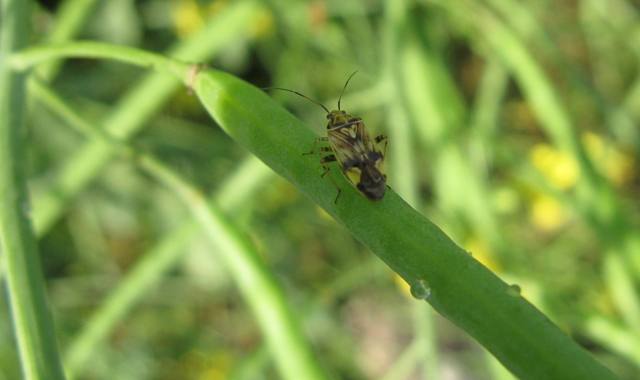
Figure 3. Lygus bug on canola pod.
Lygus bugs may also be present in sunflower and flax fields. In flax, Lygus bugs are not known to cause economic damage to flax under good growing conditions. Lygus bugs are not a concern in sunflowers for birdseed, but can be a concern in confection sunflowers, or oilseed sunflowers that will be dehulled and used for human consumption. You can not use a sweep net to monitor Lygus bugs in sunflowers. You can disturb the heads to get the insect active and assess what is present, or tap the heads over something such as a bucket or basin. Lygus bugs are active and will fly away quickly, so you need to be quick with your assessments.
Natural Enemies
Lacewing and lady beetle larvae are now showing up in some fields. These can be highly effective at helping to keep aphid levels low. So look for these while scouting fields as well.
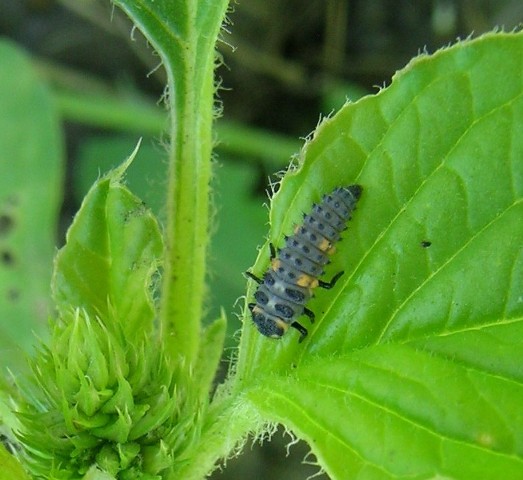
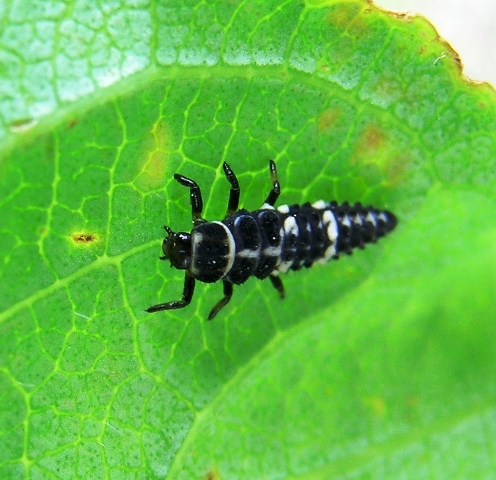
Figure 4. Larva of sevenspotted lady beetle. Figure 5. Larva of thirteenspotted lady beetle.
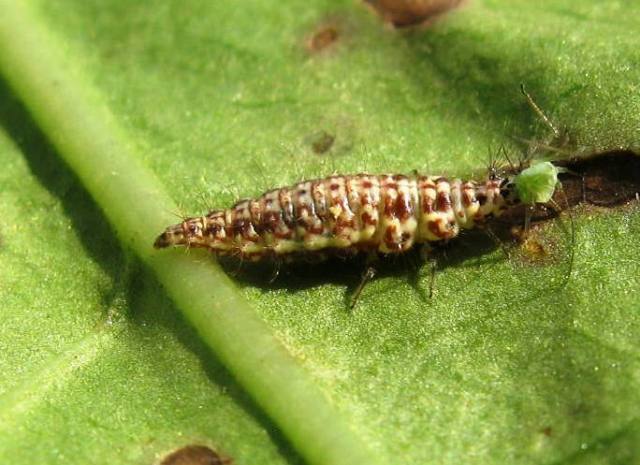
Figure 6. Lacewing larva feeding on aphid.
The number of aphids a lady beetle can eat in a day depends on the species of lady beetle, the species of aphid, and would also depend on how much time they need to spend searching for food. From a study in Manitoba, one adult female of the thirteen spotted lady beetle ate about 110 English grain aphids in 24 hours, for oat-birdcrerry aphid one adult female ate about 150 aphids in 24 hours (Malyk and Robinson. 1971.The Manitoba Entomologist. Vol. 5. 89-95). These were laboratory studies where the lady beetles always had aphids to feed on, but do show the capacity to eat large quantities of aphids when prey levels become abundant.
Insect Monitoring Programs
Bertha Armyworm: Pheromone-baited traps are used to monitor adult moths of bertha armyworm, and forecast areas that potentially could have higher levels of larvae later in the summer. Cumulative trap counts have not gone up much over the past week and currently only levels suggesting low risk of damage from the larvae have been detected. Anything under a cumulative count of 300 moths in the trapping period is considered lower risk.
The highest cumulative count in Manitoba, after 7 weeks on monitoring traps, is 192 moths. Counts are not expected to rise much in the final week of monitoring, and it is likely the forecast will be for lower risk over all of Manitoba.
Table 1. Highest Cumulative Counts of Adult Moths of Bertha Armyworm in Manitoba as of July 21, 2015
| Darlingford |
Pembina |
192 |
| Alexander |
Southwest |
180 |
| Inglis |
South Parkland |
170 |
| Douglas |
Southwest |
170 |
| Somerset |
Pembina |
165 |
| Tourond |
Eastman |
105 |
| Baldur |
Pembina |
103 |
| Roseland |
Southwest |
103 |
While scouting canola in late-July and August, it is good to have a look for bertha armyworm larvae under debris on the soil, particularly if you do see evidence of feeding.
Compiled by: John Gavloski, Entomologist
Manitoba Agriculture, Food and Rural Development
Phone: (204) 745-5668 Fax: (204) 745-5690.
To
report observations on insects or plant pathogens that may be of interest or importance to farmers and agronomists in Manitoba, please send messages to the above contact address.
To be placed on an
E-mail list so you will be notified immediately when new Manitoba Insect and Disease Updates are posted, please contact John Gavloski at the address or numbers listed above.
Manitoba Insect & Disease Update: July 21, 2015






